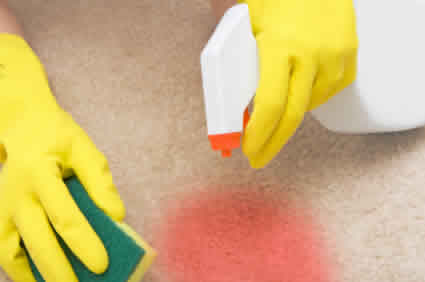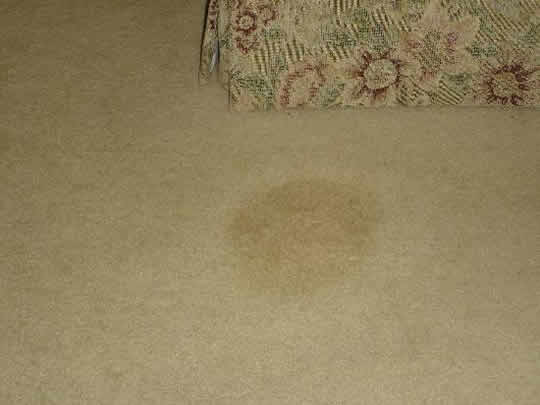Carpets naturally accumulate grit and grime. Food, mud, dirt and various liquids inevitably wind up on carpets and it’s important to know how to take care of your carpets in case of soiling. While obviously steam cleaning is usually the most efficient carpet cleaning method, the following tips will help prevent serious damage to your loved carpets. In this article you will learn the do it yourself basics of carpet stain removal.

Carpet stain removal using a detergent spray
General carpet stain removal tips
- Remove the stain as quickly as possible. If you don’t treat the stain straight away it will dissolve and blend into the carpet fibres. This will make it much more difficult to remove. The minute you spot any staining you should take immediate steps to remove it.
- Do not rub the stain. Rubbing helps the stain to spread and reach deeper into the carpet fibres. Instead of rubbing, you should gently scrape or brush off any excess material and then carefully blot the stain with absorbent towelling.
- Do not apply hot water to the stain. Hot water will cause the stain to spread and set in the carpet, so you should avoid this at all times.
- Before applying any stain removal solution, you should test the material carefully on a small, hidden section of your carpet. After applying the material, wipe off any excess solution and blot it dry. After about 10-15 minutes you should inspect the treated area. If the carpet shows a change in colour, you should avoid using this stain removal solution.
- Apply the correct stain removal agent. In general stains can be classified as either oil based or non-oil based. Oil based stains and non-oil based stains each require their own special type of cleaning agents.
- Apply only a sparing amount of cleaning agent.
- Certain stains are usually more problematic and will often require professional stain removal. These types of problematic substances include berries, beetroot, soy sauce, urine, vomit, wine, coffee and nail polish. If you are unable to remove such stains yourself, give Carpet Cleaning Parramatta a call and we’ll remove the stains for you.

Treat carpet stains promptly to avoid permanent staining.
Suit the stain remover to the carpet
Using the wrong type of stain removal substance could end up damaging your carpets.
Cotton and Linen:
Acid can easily damage cotton or linen based carpets. Even mild acids, such as lemon juice and vinegar may end up being harmful, especially if left for a long time. If using an acid based cleaning agent, you should neutralize it with baking soda or ammonia water.
Strong alkaline substances can also damage cotton, but weak alkalies can be used if rinsed immediately with water. In terms of bleaching agents, only mild bleaches such as hydrogen peroxide should be used.
Wool and Silk:
These are very delicate substances. Strong acids and alkaline substances are definitely out the question, as well as hot water. Hot water can cause wool and silk to discolour and shrink.
Safe cleaning substances for wool and silk include mild acids. Mild alkalies should be used with caution. Sodium perborate is a good bleach to use on wool.
Synthetics:
Synthetic materials are generally much more resilient. Usually acids and alkaline substances will not damage synthetic carpets. Synthetic substances tend to absorb very little moisture, so spills of coffee, tea and other liquids tend to stay on the surface and can be cleaned relatively easily.
Suit the stain removal substance to the stain
Water
As stated before, never use hot water as this can cause the stain to set into the carpet and spread. If the staining material is non-greasy, you can try applying cold water. Gently blot the stain with a damp cloth. You should clean the stain from the outside, as this will help prevent spread of the stain.
Other solvents
If the stain is caused by a greasy agent you need to use a grease solvent. Examples include turpentine, alcohol or acetone. Again you should work from the outside inside and use gentle blotting motions.
Absorbent powders
Cornstarch, talcum and other powders can work well on greasy stains which are fresh. They are generally very safe to use on all types of materials. This method is not suitable if the stain is large or if it has already dried. Often you will need to apply the powder and remove several times until you will see results.
Bleaches
 Bleaching materials such as Sodium Perborate or Hydrogen Peroxide can be useful for removing stains. They should be applied sparingly and should be removed quickly in order to prevent colour changes from occurring in the carpet. The stain should be sponged with the bleach and then sponged with a clean cloth in order to remove the substance.
Bleaching materials such as Sodium Perborate or Hydrogen Peroxide can be useful for removing stains. They should be applied sparingly and should be removed quickly in order to prevent colour changes from occurring in the carpet. The stain should be sponged with the bleach and then sponged with a clean cloth in order to remove the substance.
Soaps and Detergents
These materials can be useful for removing grease, food based stains and many other stains. Mild soaps should be used on wool, silk and other sensitive materials.
When removing carpet stains, always keep in mind the tips listed in this guide. Remember that cleaning the stain quickly is always important and make sure that you match the correct type of cleaning agent to the stain and to the carpet.